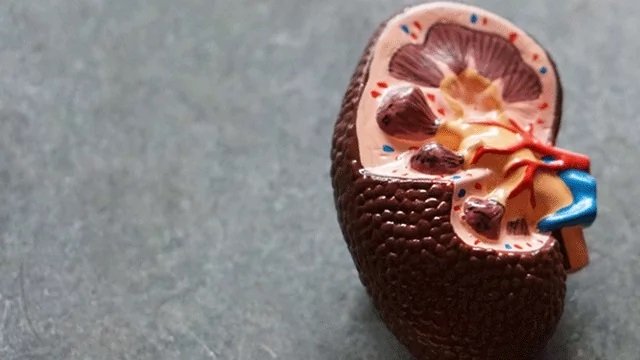Health
Kidney Stones: Symptoms, Causes, Types, and treatment

No one can define the range in size of Kidney stones; it can be as small as a grain of sand to the size of a nut. In extreme cases, it can be large as golf balls! Kidney stones are formed from the substances (calcium, oxalate, phosphate, uric acid, cysteine, and xanthine) that already exist in the urine. Usually, it passes with other body wastes unless it is crystalized or turns into higher concentration due to a lack of urine volume. People who take an inadequate amount of water are more prone to kidney stones.
Symptoms
Most people never undergo extreme pain due to the small size of kidney stones; in those cases, stones may pass through the urinary tract without causing any obstacle. In other cases, people may show some severe or early signs if the stone turns into a larger size. The symptoms may follow;
- Excruciating Pain while urinating
- Presence of Blood in the urine
- Sharp pain in your back or lower abdomen
- Nausea and vomiting
Consult the urologist without neglecting these symptoms as soon as possible to get timely treatment.
Causes
There is no single or definite reason behind the kidney stone; several interior and external factors are involved in the formation.
In general, the risk of kidney stones increases when the presence of calcium, oxalate, and uric acid (crystal-forming substances) exceed, which cannot be diluted in the urine. Also, the lack of elements that prevent these substances from joining together creates an environment for stones to occur.
Types of Kidney stones
It is necessary to determine the type of kidney stone before moving to the treatment, as it gives the clearer view and reduces the risk of recurrence in the future. There are several different kinds of stones which can be diagnosed through a few tests.
Types of kidney stones include:
- Calcium stones – In most cases, kidney stones are generally witnessed to accumulate excess calcium oxide, which takes the form of stones. Many food items produce and contain high-oxalate, which is absorbed in the body. High dosage of Vitamin-C & D supplements or metabolic disorders also increases the concentration of oxalate and calcium in the urine.
Calcium stones also occur due to high calcium phosphate deposits, which can be consumed through supplements and medications. - Struvite stones – These stones are formed due to the high rate of urinary tract infection. Struvite stones tend to proliferate larger without showing many symptoms in the early stage.
- Uric acid stones – Patients who intake a high protein diet daily, hypertension, or diabetes/metabolic syndrome have a higher risk of developing Uric acid stones. These stones can be easily formed in the body of a person who has lost much water level due to chronic diarrhea or surgical reasons. Genetic factors can cause uric acid stones in most cases.
- Cystine stones – Cystine stones have commonly occurred in the case of any sort of hereditary disorder. In this, the patient’s body excretes a lot of amino acids, leading to a formation of stone in the kidneys.
Treatment
Kidney Stones Treatment depends upon the size and position in the urinary tract. Some conventional treatment methods include;
- Natural way – Stones of small size may not need complex procedures to pass out of the patient’s body through urine. The doctor will suggest increasing liquid intake and mild medicines that ease the blockage.
- Medications – The concerned urologist will prescribe medications according to the severity of the patient’s conditions. These medicines will help to relax the ureter and allow stones to pass or break into pieces.
- Minimally Invasive Surgeries – In case of operative surgery, the doctor will go for one of the three procedures: ureteroscopy, shockwave lithotripsy, and percutaneous nephrolithotomy.
- Ureteroscopy: Performing ureteroscopy requires the involvement of a specially designed instrument ureteroscope, which is directly inserted in the urethra through the bladder into the ureter. The instrument allows the surgeon to see stones, which he surgically retrieves in “basket” or passes a laser beam to break into small pieces. These small-sized stones then exit through the urinary tract more easily than before.
- Shockwave lithotripsy: In this procedure, a specialized surgical table/tub is placed where the patient is directed to lie upon for the process. The surgeon will make the high-energy shock waves pass through the location where stones reside in the body. Like in ureteroscopy, the stones will be broken into small pieces through shock waves that make a smooth exit through the urinary tract.
- Percutaneous nephrolithotomy: Percutaneous nephrolithotomy is considered when either treatment cannot be applied due to stones’ big size, heaviness, or location. Sometimes when small stones are present in too many numbers, then also percutaneous nephrolithotomy is applied.
In this procedure, the surgeon will make a small incision on the patient’s back to insert in a tube directly into the kidney. After that, stones are fragmented through the ultrasound probe and suctioned out in a one go, so the patient doesn’t need to pass any stone or residual. Once done, a urethral stent is inserted a few days after the surgery, which will be removed further. The patient might require an overnight stay for observation at the hospital.
-

 Gadget4 weeks ago
Gadget4 weeks agoAfter Grand Success on BLDC Ceiling Fan, Eff4 Is Launching Smart Bulb
-

 Festivals & Events4 weeks ago
Festivals & Events4 weeks agoGoogle Celebrates Cherry Blossom Season with Animated Doodle
-

 Business3 weeks ago
Business3 weeks agoPrakash and Kamal Hinduja: Driving Social and Environmental Change
-
Education3 weeks ago
Fred DuVal: University Leadership as a Critical Resource for Climate Change Research and Life-Saving Solutions
-

 Health3 weeks ago
Health3 weeks agoThe Hinduja Brothers Commitment to Global Health: Empowering Communities Across Borders
-

 Cryptocurrency3 weeks ago
Cryptocurrency3 weeks agoDesigned For The Masses: How Akasha (AK1111) Is Unlocking Crypto For The Next Billion Users
-

 Cryptocurrency3 weeks ago
Cryptocurrency3 weeks agoNexaglobal & Future World Token (FWT): Could This Be the Next Big Crypto Investment of 2025?
-

 Sports4 weeks ago
Sports4 weeks agoWomen’s NCAA Tournament 2025 Sweet 16: Full Schedule, Fixtures, Teams, Bracket, and How to Watch March Madness Basketball Match Live














